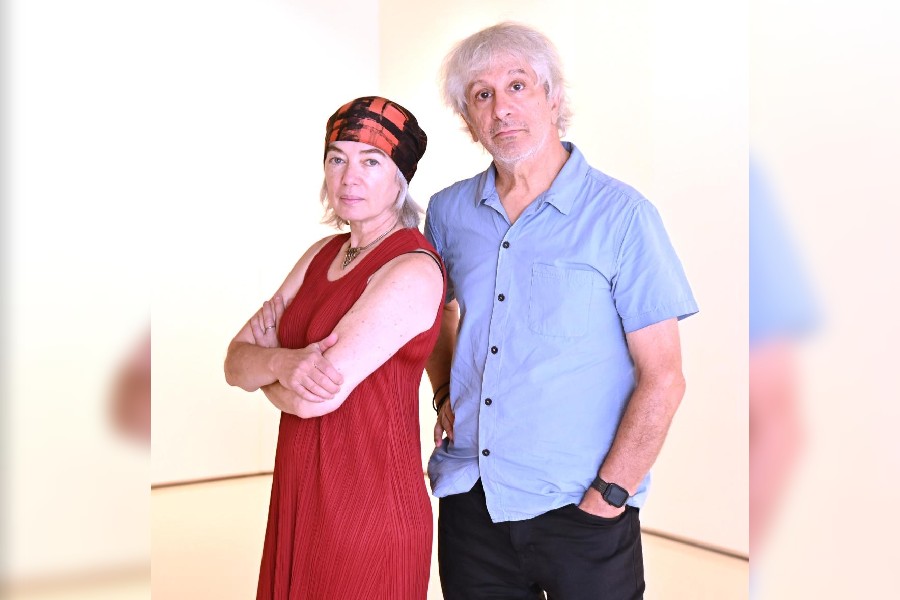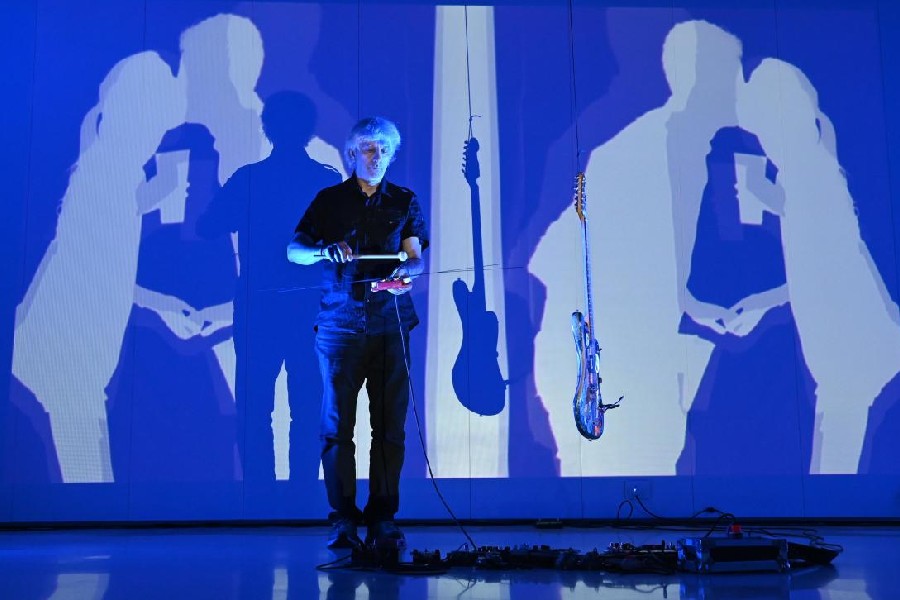Ahead of Ziro Festival that was held between September 28 to October 1, guitar virtuoso Lee Ranaldo, the co-founder of the American rock band Sonic Youth, and visual artist Leah Singer (also his wife) brought their Contre Jour tour to Calcutta. Their performance at Triart, an art space that’s yet to be launched on Hazra Road, Ballygunge, focused on their project of trying to blend music and visual arts. The duo have been working on the avant-garde project for 30 years and have named the three parts of their series Drift, Sight Unseen and Contre Jour. The two artistes focus on exploring how image and sound interact during a live performance and use real-life footage from their tours across the globe and club it with the soundscape and create a sonic experience.

Leah Singer and Lee Ranaldo
The projector and the “suspended guitar phenomena” with his famous Fender Jazz Bender gave way to shadow-play and highlighted illusion and movement. Their piece was preceded by a theatrical performance titled #5 by Culture Monks (a Calcutta-based group). Inspired by the philosophy of pancha kosha—– evolving from chaos to harmony, the piece was performed by Pradip Chattopadhyay aka Bulada (from Mohiner Ghoraguli), Janardan Ghosh and movement artiste Bibhas. t2 spoke to Lee Ranaldo for an insight into Contre Jour.
Why the title Contre Jour?
Contre Jour in French means ‘against the light’. We’re working with the idea of light and shadow. There’s a point where light casts my shadow on the screen and there are other shadows already on it. This is an outgrowth of a concept we’ve been working on for the last 30 years. We started together in 1991, first with 16mm projectors and then eventually video and, most recently, with the idea of playing with light and shadow. In a sense, it’s similar to the earliest form of cinema, which was just projected shadows on a wall.
What kind of impact does it have on the audience?
We’re both trained in experimental cinema and experimental music and it’s a joining of the two, in a way that is very much coming out of the things happening in New York for the last 50 years. Experimental cinema and musical experimentation in New York, playing with the idea of sound, and so on. There’s a performative aspect, it’s kind of theatrical and there’s a music concert and also a cinema aspect. It depends on the audience... which part of the act they’d like to focus on, they mix their own version, and someone might concentrate on the images on screen or the suspended guitar. Everyone can interpret it their way.
How did you two zero in on the idea?
When we met, Leah was already doing experimental projection with musicians — improvisations with 16mm projectors in a technique that’s unique to her. I was also doing experimental concerts where I was doing guitar improvisations and other things, but I was making my own video projections. When we met, we started trying something together and it just turned into something that we continued to work on. In some ways, there’s the audio that I’m making with the guitar and there’s also audio from the soundtrack of the video. We’re always collecting sound and images and folding things back into our next performance. In some sense, it’s like a diary or a journal of our lives. Some videos are from the places we travel to, and the audio has been recorded in different cities, so it has a personal aspect as well. It’s basically an experimental cinema performance.
What are the challenges?
The challenge is to get everything to work right (laughs). One of the challenges is the different spaces you perform in. The space in Calcutta is starkly different from what we usually perform in. We perform in actual theatres with a stage and sometimes outside in a plaza. So the challenge is adapting to each local space.
A leap from rock and roll to something so experimental!
The journey has been ongoing side by side when Sonic Youth was playing rock and roll and also doing long improvisational acts as part of our show. There’s hardly any separation. We’re really excited to be in India and absorb Indian culture, art and music, and maybe take some of that back with us and incorporate that into our performance. I saw Durga idols being made and captured some footage. I’m looking forward to the next part of my journey.










